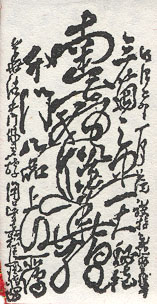 |
Udana-in Nichiki (1800-1859) was a great scholar and reformer of Nichiren Buddhism who helped to establish the modern education system of the Nichiren Shu. He also taught that the present age demands the practice of shoju rather than shakubuku. He argued that the Rissho Ankoku Ron was no longer applicable to the times and that a new method of propagation would need to be used in a time when religious debate was no longer a convincing or effective means of converting others.
Nagamatsu Seifu Nissen (1817-1890) was originally a priest of the Honmon Hokke Shu, but he left that school due to his disgust with the corruption of the clergy. In 1857, he founded the Butsuryu-Ko in Kyoto. This became the Honmon Butsuryu Shu.
|




